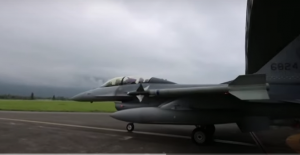China has conducted mock missile strikes against Taiwan on a second day of military drills, which it said was testing its ability to “seize power”, and inflict punishment for “separatist acts” after the inauguration of the island’s new president.
The exercises, which involved Chinese military units from the air force, rocket force, navy, army and coastguard, were announced suddenly on Thursday morning, with maps showing five approximate target areas in the sea surrounding Taiwan’s main island. Other areas targeted Taiwan’s offshore islands, which are close to the Chinese mainland.
China’s defence ministry said the drills on Friday were testing its military’s capability to “seize power” and occupy key areas, in line with Beijing’s ultimate goal of annexing Taiwan. Taiwan’s government and people reject the prospect of Chinese rule, but China’s ruler, Xi Jinping, has not ruled out the use of force to take the island. Western intelligence has claimed Xi has told the People’s Liberation Army to be capable of an invasion by 2027.
Lai Ching-te speaking into a microphone while visiting a military base
On Friday, China’s state broadcaster said jets loaded with live ammunition, and formations of bombers had run mock strikes against Taiwanese targets. CCTV said missiles launches were also practised and an accompanying animation highlighted the cities of Taipei, Hualien, Taitung and Kaohsiung as targets. Fiery PLA propaganda mentioned its Dongfeng ballistic missiles, but without specific suggestions they would be used in the drills.
Citing a Taiwan security official, Reuters reported the planes had also conducted mock bombings of “foreign vessels” in the Bashi Channel, which runs between Taiwan and the Philippines.
It was not immediately clear what vessels were targeted – the waters around Taiwan hold lots of commercial traffic – but in the event of a Chinese attack on Taiwan there would be pressure on foreign militaries including the US and Japan to get involved.
China’s coastguard said it had run “enforcement drills” off Taiwan’s east coast, and at least three coastguard vessels were seen on online ship trackers, patrolling Taiwan’s south-west. The Taiwan official also told Reuters the coastguard had conducted “mock inspections” of civilian boats in the east and about 24 warplanes approached close to Taiwan, but none entered Taiwan’s contiguous zone extending 24 nautical miles offshore.
On Thursday Taiwan detected 35 PLA navy and coastguard ships and 49 warplanes, of which 35 crossed the median line, the de facto border between China and Taiwan.
China launches drills around Taiwan after inauguration of new president – video
1:26
China launches drills around Taiwan after inauguration of new president – video
In response, Taiwan has scrambled jets, deployed navy vessels to monitor the PLA, and moved anti-ship missile systems to coastal areas. On Friday its defence ministry released footage it said showed its airforce tracking a Chinese H-6 bomber and a J-16 fighter jet.
Taiwan’s foreign minister, Lin Chia-lung, said Taiwan would make no concessions because of the drills “because it concerns the development of democracy in Taiwan”.
The rhetoric has been high but these drills are smaller in scale than those held in 2022 and 2023. Beijing did not declare any no-fly zones, and no live fire was used on Thursday except in practice areas on the Chinese mainland, according to Taiwan’s military.
On Thursday, China’s foreign ministry spokesperson, Wang Wenbin, said: “Taiwan independence forces will be left with their heads broken and blood flowing after colliding against the great … trend of China achieving complete unification,” according to a Reuters translation.
An editorial in China’s official state media on Friday said the drills were “legitimate, timely and entirely necessary, as ‘Taiwan independence’ acts in any form cannot be tolerated”. It said China’s countermeasures were “inevitable” after the “serious provocation” of Lai’s inauguration speech.
Lai was inaugurated as Taiwan’s president on Monday after winning democratic elections in January. Lai and his predecessor, Tsai Ing-wen, are from the pro-sovereignty Democratic Progressive party (DPP), which Beijing considers separatist.
In his inauguration speech Lai affirmed Taiwan’s sovereignty, promised to defend it, and urged China to end hostilities. Any speech by a president belonging to the DPP, short of capitulating to Beijing’s position that Taiwan belongs to China, was likely to provoke an angry response.
Taiwan air force pilots run toward F-16V fighter jets during a military drill.
China-Taiwan relations: what’s behind the tensions – in 30 seconds
Read more
A conflict over Taiwan would be catastrophic, and likely involve other countries in the region and beyond. In response to the drills, representatives from Japan, the US, South Korea and Australia called for calm. The US state department told Taiwan’s Central News Agency that it was closely monitoring the situation, while Australia’s foreign minister, Penny Wong, warned that “the risk of an accident, and potential escalation, is growing”.
The EU said it had “a direct interest in the preservation of the status quo in the Taiwan strait” and opposed “any unilateral actions that change the status quo by force or coercion”.
A spokesperson for the UN secretary general, António Guterres, said the organisation was following developments in the Taiwan strait and urged “relevant parties to refrain from acts that could escalate tensions in the region”.
On Chinese social media the drills made up at least three of the top 10 trending topics on the tightly controlled Weibo platform, with most visible comments highly supportive of “unifying” Taiwan. In Taiwan, there was no visible panic or negative effect on the stock market. Many people instead focused on a controversial bill that has sparked physical fights in parliament. Critics say the bill threatens the functioning of government.
The Guardian

